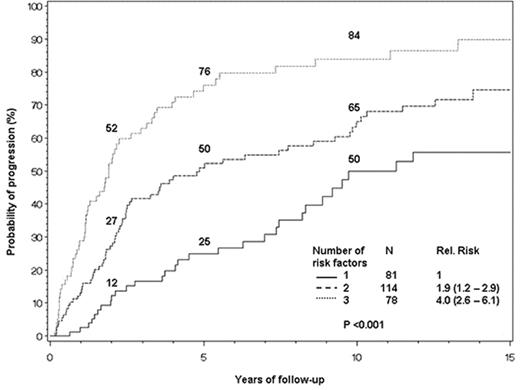Abstract
Background: Smoldering multiple myeloma (SMM) is an asymptomatic plasma cell proliferative disorder with a high risk of progression to symptomatic multiple myeloma. Identification of risk factors that predict progression of SMM to symptomatic MM could identify higher risk patients who might benefit from chemoprevention or more intensive surveillance. We hypothesized that increased monoclonal free kappa or lambda immunoglobulin light chains in smoldering myeloma (SMM), as detected by the serum free light chain (FLC) assay, indicates an increased the risk of progression to active myeloma.
Methods: Of 276 pathologically confirmed SMM patients seen at the Mayo Clinic from 1970 to 1995, baseline serum samples obtained within 30 days of diagnosis were available in 273.
Results: At a median follow-up of surviving patients of 12.4 years, transformation to active disease has occurred in 161 (59%) patients. An abnormal FLC ratio was present at baseline in 90% of patients. The best break-point for predicting risk of progression was a FLC ratio less than or equal to 0.125 or greater than or equal to 8 (hazard ratio, 2.3; 95% CI, 1.6–3.2) [Figure 1]. The extent of abnormality of FLC ratio was independent of SMM risk categories defined by number of plasma cells in the bone marrow and size of serum M-proteins (bone marrow plasma cells ≥ 10% and serum M protein ≥ 3 g/dL; bone marrow plasma cells ≥ 10% but serum M protein < 3 g/dL; and serum M protein ≥ 3 g/dL but bone marrow plasma cells < 10%). Incorporating the FLC ratio into the risk model, the division of patients into high-, intermediate-, and low-risk groups is 28, 42, and 30% with 5 year progression rates of 76, 51, and 25%, respectively [Figure 2].
Conclusions: The serum immunoglobulin FLC ratio is an important additional determinant of clinical outcome in patients with SMM.
Author notes
Disclosure:Research Funding: Reagents from Binding Site.



